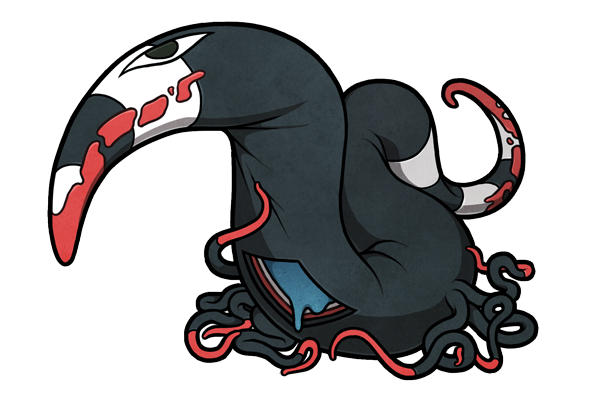

Toribori
the Ransomers
prefix tori suffix bori
torutoruaxialaxial toruaxiali
physical appearance
The toribori /ˈtɔːriˌbɔːri/ is a large, pointy-snouted stranger with three layers of thick, rubbery skin. The mid layer is red, while the innermost is white; only the surface layer bears markings. The lip-like markings on the toribori's snout and tail are vivid only at the very first stage of its life, and grow blotchy as it ages, finally disappearing altogether once it reaches the midpoint of its life. It has either seven, nine, or eleven tendril-like arms, each of which is tipped in red. These markings, like those on its face and tail, recede as the toribori ages, until only the very tip remains red.
The toribori is filled with a fine blue sand, which grows cement-like when exposed to air, almost immediately plugging any wound that occurs to become scab-like. Over the course of several weeks to a month, these scabs heal and become indistinguishable from the rest of its skin in both color and texture. Although it cannot regenerate any lost sand, and a loss of inner mass can lead to potential drooping of form and lowering of stability, injuries do not tend to disgorge enough sand for this to be a problem. As such, the toribori can sustain even significant injury with little effect, being resistant to all heat, cold, and electricity as well.
Its voice sounds like a singing human being, its tone joyous to the point of exultance.
a delighted, if not operatic melody.

environment and generation
The toribori appears in large, but isolated cities, with desert metropoles being its most common environment. One toribori generates for every million people within a city.
In the center of vast, open lots or similar spaces (including rooftops in 3% of instances), the toribori begins in a slender, neotenic stage no larger than a fist. It grows thicker in swells as its sand multiplies in quantity, its tendrils squirming outward from red spots. It grows larger in size and more mature in proportion week by week.
behaviour and effects
Once the toribori is fully mature, it becomes both exploratory and attendant of its surroundings. Its main behaviour is the creation and maintenance of "charnel rooms". It uses its long tendrils to repeatedly hollow out spaces beneath buildings, utilizing buried walls, pipes, and beams to form the parameters of the space. Though not small (usually around 6x2x2 feet in size), the toribori does not enter these spaces, and is careful to hide the entrances in such a way that these hollows are not immediately visible to passers-by. Toribori display dominant "handedness" in their actions, preferring to use the side of their body which possesses more arms. They are more frequently left-handed than right.
When not attending to its rooms, it stays on the move within its large territory, pulling itself forward with a lithe weaving. It pauses at unpredictable intervals to look out across any visible expanses of flatness (with the sky, the sea, or the desert ring being its preferred sights), but otherwise behaves in a more-or-less automatic manner.
Those toribori that appear on rooftops, however, engage in no other actions aside from this wistful stare.
interactions with sensitives
The toribori, during the beginning phases of an encounter, remains ambivalent to sensitives. Its demeanor changes in an abrupt manner after 1,000 seconds of exposure, at which point the toribori approaches a sensitive with an efficient insistence, grabbing them with at least one of its tendrils. If successful in this capture, it takes the sensitive to one of its charnel rooms, which always have entrances just larger than the shoulder diameter of the average human being. Using force if necessary, the toribori shoves the sensitive into one of these rooms, although the entrance remains unsealed. Though the toribori is not malicious in its actions, it usually inflicts some level of incidental injury to the sensitive, making escape difficult.
Proximity to the toribori creates the visual illusion that the ground丆, and all the objects upon it, are duplicated in the sky. Though this effect does not occur within any interior spaces, it does occur when the sensitive is inside of a charnel room. Inside the room, however, the mirroring effect takes on a distorted, blade-like, metallic effect丌 the longer that visual contact persists.
丆 The city stretches on above as below, and the sky is pushed from view. You don't feel trapped; you know already that there can never be any escape.
Rey Crud. Hypotheum.
aging and death
During the final tenth of the toribori's lifespan, it becomes fully indifferent to sensitives. Instead, it begins to construct charnel room large enough to house its form, and once the space is fully made hollow, the toribori squeezes inside and dies contentedly.



